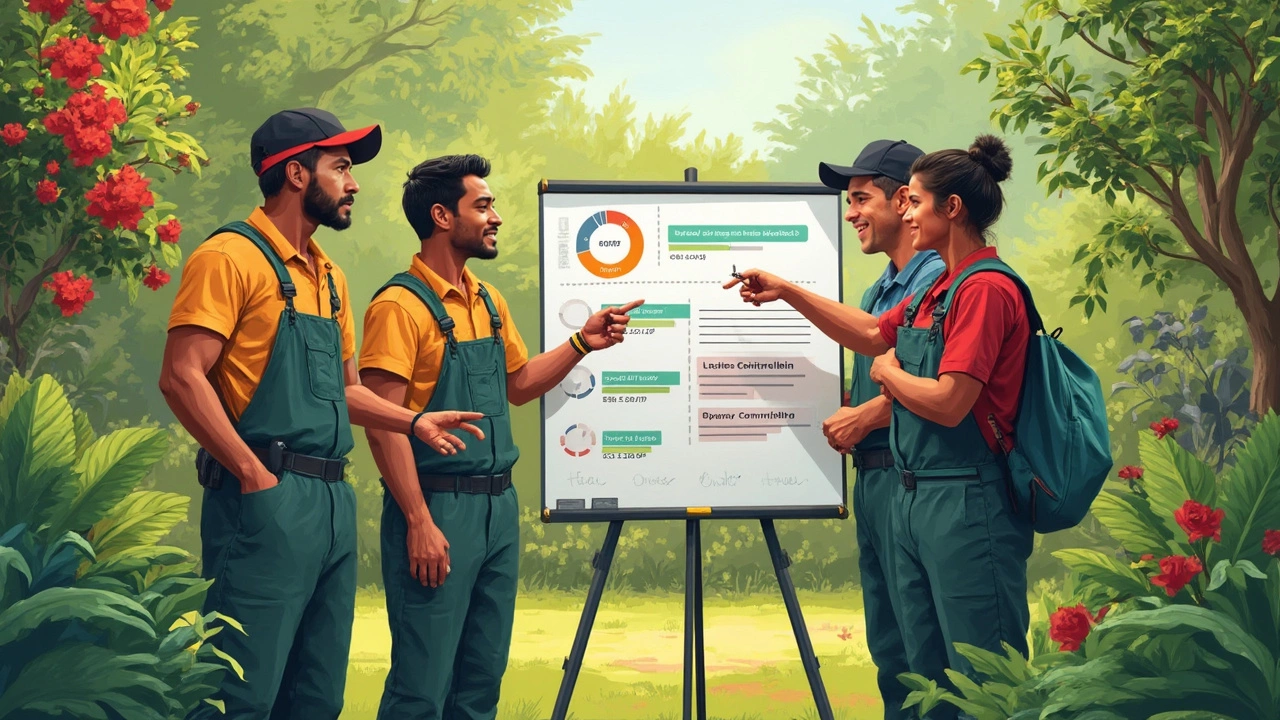Think landscaping is just mowing lawns for minimum wage? Think again. Some folks in the field are pulling in paychecks that rival jobs people spend years in college chasing. Of course, not every landscaping role lands you at the top, but breaking down the numbers can be eye-opening.
Let's get one thing clear: Experience counts. A rookie might start around $15 an hour, depending on where they live, but seasoned landscapers with specialized skills can see $25, $30, even $40 an hour or more in high-demand regions. If you run your own landscaping company, you could bring in six figures, especially if you offer things like hardscaping, design, or irrigation systems.
- How Much Do Landscapers Really Make?
- What Does It Take to Reach Top Pay?
- High-Paying Landscaping Roles Explained
- How to Boost Your Earnings Fast
- Real-Life Tips from Top Earners
- Is Top Pay Worth Chasing?
How Much Do Landscapers Really Make?
If you’re wondering about paychecks in landscaping, there’s a big gap between entry-level and top-tier money. In most of the U.S., a beginner landscaper usually starts at around $15 to $17 an hour. That's not bad if you’re just getting your feet wet, but it gets more interesting as you rack up experience and skills.
Once you move up, say with 3-5 years on the job and solid references, the hourly rate can climb to $20 or $25. If you stick with it and build a reputation for reliability (and don’t mind working in the heat), you can become a crew leader or a specialist and pull in even more.
| Position | Average Hourly Pay | Yearly Salary (Approx.) |
|---|---|---|
| Entry-Level Landscaper | $15 - $17 | $31,000 - $35,000 |
| Experienced Landscaper | $20 - $25 | $41,000 - $52,000 |
| Landscape Crew Leader | $25 - $35 | $52,000 - $72,000 |
| Landscape Designer/Foreman | $30 - $45 | $62,000 - $93,000 |
| Business Owner | Varies—up to $100K+ | $60,000 - $150,000+ |
Of course, it’s not all about years. The jobs that pay at the high end usually ask for special skills, like running excavators, installing irrigation systems, or landscape design. Popular areas like California, Texas, and the Northeast sometimes pay 10-20% more than the national average because demand is higher and there’s more money flowing into outdoor spaces.
If you’re eyeing landscaper pay as a career step, watch for chances to grow into specialty roles. The difference in your take-home can add up fast, especially if you stick it out and grab certifications or extra training.
What Does It Take to Reach Top Pay?
If you’re serious about getting top pay as a landscaper, you’ll need more than just stamina and a push mower. The folks earning the highest checks worked up from the bottom, but every step up added extra skills, better tools, and smarter business moves. Here’s the lowdown on what really matters if you want to be at the top of the landscaper pay pyramid.
Specialized training makes a big difference. If you get certified in things like irrigation, pesticide application, or landscape design, you can basically name your price in some markets. The more complicated the job, the fewer people can do it, and that drives up the pay. Some states even require licenses for certain tasks, so if you land those, you’re already ahead of most.
Another big one is leadership. Crew leaders, foremen, and project managers always make more than someone just working the shovel. The minute you can organize a team or manage client jobs without anyone babysitting you, bosses notice—and pay jumps. A lot of companies also favor folks who keep up with new landscaping tech: robotic mowers, water-saving irrigation controllers, and special green building methods. If you know your way around this stuff, you’re golden.
Check out the kind of boosts the right moves can get you in the table below:
| Landscaper Role/Skill | Typical Hourly Pay Range (2025) |
|---|---|
| Entry-Level Laborer | $15-$19 |
| Certified Pesticide Applicator | $20-$28 |
| Irrigation Specialist | $23-$35 |
| Crew Leader / Foreman | $25-$38 |
| Landscape Designer | $30-$50+ |
| Business Owner (small/independent) | $60,000-$150,000/yr |
Want to move up faster? Pick a niche few others know. Things like stonework, water features, or native planting design can mean way less competition and higher price tags. Don’t forget, keeping a good relationship with clients fuels referrals, which usually means bigger, more interesting jobs. No surprise: showing up on time, doing solid work, and being easy to deal with make you the first person someone calls for their next project.
High-Paying Landscaping Roles Explained
Not all landscaping jobs are created equal. Some roles stand out for their higher pay, and if you're looking to level up your income, it's smart to know where the money flows. While entry-level positions tend to stick with basic yard work, these top-paying roles show how the industry rewards deeper skills.
- Landscape Designer: These pros use software and practical know-how to create beautiful, functional outdoor spaces. Designers often work with homeowners, businesses, or even city planners. Many make $55,000-$75,000 a year, and some in busy metro areas or with their own business can hit six figures.
- Landscape Architect: This job usually requires a college degree and a license, but the pay can easily hit $65,000-$100,000 or more, especially in big cities. Architects design large parks, corporate spaces, or high-end residential projects from scratch.
- Hardscape Specialist: These folks build patios, retaining walls, stone pathways, and water features. The work is physically demanding, but skilled hardscapers often make $25-$40 per hour—sometimes even more if they run a crew or have a strong reputation.
- Foreman or Crew Leader: If you know how to manage a team and keep projects running smoothly, crew leader roles often pay $20-$30 per hour, with the best pulling in $60,000+ per year plus bonuses.
- Irrigation Technician: Setting up and repairing sprinkler systems pays well, especially for certified techs. Irrigation work is valued for its technical skills, often paying $22-$35 an hour in places with water restrictions.
- Business Owner/Operator: If you’re running a landscaping company, your income depends on how much business you drum up and how well you manage costs. Owners who hustle, network, and offer specialized services can bring in $100,000 to $250,000 annually, sometimes even higher, though earnings can swing between seasons.
Want to land one of these roles? Get certified, try new tools, or pick up a specialty like fish ponds or eco-friendly design. The more you know beyond the basics, the more you can charge. That’s how you put yourself at the top of the landscaper pay scale without burning out.

How to Boost Your Earnings Fast
If you’re tired of seeing the same numbers on your paycheck, it’s time to work smarter. Landscapers who pull in top cash share a few secrets that anyone can use—no matter your starting point. Getting to the top pay for landscaper level isn’t guesswork.
Getting extra certifications is one big move. For example, earning a pesticide applicator’s license can land you $2–$4 more per hour on average. Irrigation tech certificates are another smart call since more clients want advanced sprinkler systems, and those jobs can pay 15–25% higher than standard landscaping work.
Specializing is another shortcut. If you focus on stonework, tree care, or landscape design, your hourly rates can almost double what the average crew member makes. For instance, certified arborists often earn $55,000–$85,000 a year, even when starting out.
Here’s a quick breakdown of popular ways landscapers get paid more:
- Learn new skills—like hardscaping or lighting installs—that clients pay premiums for
- Offer seasonal services (like snow removal in winter or spring cleanups) to fill the gaps
- Negotiate your rates after proving your value—especially if you take on extra responsibility
- Work for commercial clients instead of just residential jobs, since they often pay 20–30% more
- Network with contractors and property managers so you're first in line for bigger projects
Check out real numbers for 2024, so you see what’s possible if you up your game:
| Service/Specialty | Average Hourly Rate |
|---|---|
| Basic Lawn Care | $15–$22 |
| Hardscaping | $28–$45 |
| Tree Work (Certified Arborist) | $30–$48 |
| Irrigation Installation | $25–$40 |
| Landscape Design (with portfolio) | $45–$65 |
Don’t forget, communication skills sell. Landscapers who stay in touch, show up on time, and keep clients in the loop are the ones who get referred—and paid—the most. Your reliability can sometimes bump your rates more than another year on the job.
Real-Life Tips from Top Earners
If you want to crank up your earnings in landscaping, it helps to listen to the people already cashing big checks. These top earners aren’t winging it—they’ve figured out smart ways to stand out and charge more for their work.
One standout fact: A 2024 survey by Lawn & Landscape magazine found that landscape business owners in major cities regularly take home over $100,000, and even high-level crew leaders can pull in $60,000 or more with overtime and bonuses. How do they do it? It’s not magic—just a mix of hustle, focus, and know-how.
- Specialize in demand-driven skills. Adding services like tree removal, irrigation install, or patio construction can bump your hourly rate up by 30% or more.
- Invest in better equipment. Top earners say owning rather than renting tools saves money over time and gets you bigger jobs.
- Sell service packages, not just one-off jobs. Customers stick around longer, and you lock in steady work for each season.
- Network hard. Joining local business associations and making friends with builders or realtors gets you referrals you’d never find otherwise.
- Stay on top of certifications. Most of the highest earners keep adding to their skills with certifications in landscaping, safety, or pesticide application. Some states even pay bonuses for it.
Here’s how that top pay breaks down in real life:
| Job Role | Typical Hourly Pay | Annual Earnings (Full-Time) |
|---|---|---|
| Entry-Level Landscaper | $15–$18 | $31,200–$37,440 |
| Skilled Crew Leader | $22–$28 | $45,760–$58,240 |
| Specialist (e.g., Hardscaping, Irrigation) | $30–$50 | $62,400–$104,000 |
| Business Owner | Varies | $80,000–$150,000+ |
Curious how the top 10% in the industry stay at the front? They check out landscaping expos, master new gear fast, and say yes to projects most people turn down. And when it comes to landscaper pay, customer service matters. Top earners respond quick, show up clean, and never ghost on promises. That gets them the repeat business everyone else misses.
Is Top Pay Worth Chasing?
Here’s the deal: Chasing the landscaper pay ceiling is not just about stacking dollar bills. Sure, top salaries can hit $80,000 to $100,000 per year for skilled supervisors, designers, or self-employed business owners in busy cities. But those numbers don’t always tell the whole story about what a day on the job feels like—or what you give up to get there.
| Job Title | Typical Top Salary | Hours/Week |
|---|---|---|
| Entry-Level Landscaper | $34,000 | 35-40 |
| Experienced Crew Lead | $55,000 | 40-50 |
| Landscape Designer | $75,000 | 40-45 |
| Landscape Business Owner | $100,000+ | 50+ |
Moving up isn’t just about earning power. Top positions usually mean more pressure—coordinating teams, solving client issues, bidding on contracts, managing tight deadlines, and handling the stress of weather delays or equipment costs. If you love working outside with your hands, you might find the paperwork and sales part of the top gigs less fun.
The smart thing is to figure out what you really want. The best-paid folks in landscaping tend to:
- Get extra certifications (like irrigation tech, hardscape design, or pesticide application)
- Get comfortable with sales and customer service
- Stick around in the industry long enough to build a solid reputation
- Take on the risks and rewards of managing people and business finances
What’s the trade-off? You’ll probably work more hours—especially in peak season. You might spend as much time managing screens and spreadsheets as riding mowers. But for some, the pride in building a business and the bigger bank deposits are totally worth it.
So, is the climb to top pay worth it? It depends if you want the extra cash bad enough to take on the bigger workload and responsibility. If you’re cool with leading teams and learning new skills, the top spots in landscaping are wide open.






